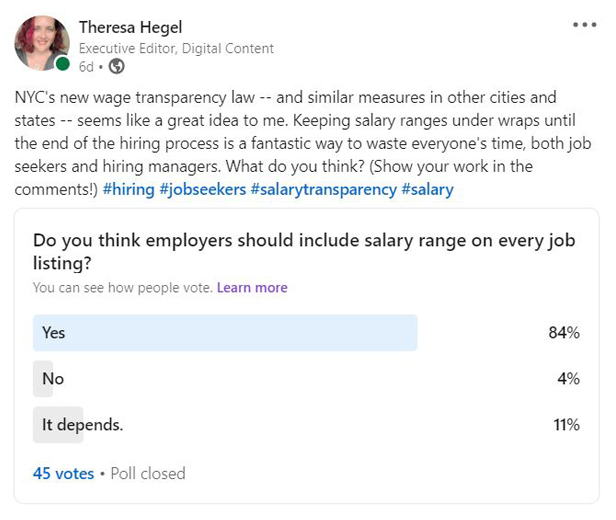February 15, 2022
The Pay Transparency Movement Is Growing – And That’s a Good Thing
A law in New York City will require employers to disclose salary ranges for open positions. Though it’s gotten pushback from some business groups, it’s a positive development both for job seekers and job creators.
Earlier this month, a Brooklyn-based travel writer tweeted about her salary from a job she was leaving, urging applicants of her newly open position not to accept anything less than $115,000 per year, plus signing and relocation bonuses. The tweet promptly went viral, sparking conversation and congratulations – but also inspiring many to share their own salary histories on social media.

In January, a freelance recruiter noted on Facebook that she’d offered a candidate $85,000 for a job when the company’s budget for the position was $130,000, noting that it was what the candidate had asked for and the recruiter didn’t “have the bandwidth to give lessons on salary negotiation.” This post also made the rounds on Twitter, though the responses were decidedly less supportive of the original poster.
Comparing pay has always been one of those conversational taboos in the U.S. – something that’s shared in whispers, if at all. But online discussions like the above are lifting some of the secrecy, and that’s a good thing, particularly for women and people of color. Studies have shown that when employers are upfront about the range of compensation they’re offering for a position, it can help to narrow the wage gap, leveling the playing field when it comes to salary negotiations.
The movement toward salary transparency has been growing during the so-called Great Resignation (or is it now being referred to as the Great Reshuffle?), and not just at the individual level. A number of cities and states require some level of pay disclosure. California kicked things off a few years ago by requiring employers to provide pay scale to external applicants if they requested it, but only after the applicant had completed their first interview. The state of Maryland also has a law that requires employers to disclose pay scale upon request, and the Ohio cities of Cincinnati and Toledo require disclosure after conditional offer of employment. A handful of other states have followed suit with their own versions of salary transparency. Colorado became the first state to require employers to include the available pay range in job postings.
The latest government to tackle the issue is New York City. Its salary transparency law goes into effect in April and will apply to employers with more than four employees, though it excludes temp firms. Not posting the minimum to maximum salary range on a job listing could result in a fine of up to $125,000.
“Our new law shines a light on pay inequity,” Helen Rosenthal, a former City Council member and sponsor of the bill, told CNN. “Including pay ranges in job postings allows job seekers to determine whether they will be able to support themselves and their family when they apply for a job.”
As you might imagine, salary transparency is popular with employees and job seekers, but not as thrilling to the business world at large. Some business leaders, for example, have argued that sharing pay information could lead competitors to poach their top candidates. Plus, employees who know they’re at the top of the pay scale for a position might be prompted to move on if their company doesn’t offer opportunities for promotions. Another issue arises when companies don’t have a well-thought-out pay structure. Without a formalized compensation plan that can be explained, businesses may open themselves up more easily to accusations of bias.
An informal poll I ran last week on my LinkedIn page found that 84% of respondents believe employers should include salary range on every job listing, and only 4% disagreed. (The rest say it would depend on the situation.)
Kevin Wilkins, owner of Swag City in Williamsburg, VA, said: “My job application days are gone, but I can’t imagine a scenario where I would have ever been tempted to apply for a job with no clue as to what they were expecting to pay me.”
To me, keeping potential compensation under wraps until the very end of the hiring process seems like a great way to waste time, for both the candidate and the employer. Why go through however many rounds of interviews with a candidate only to find out your top choice is looking for more money than you’re able to offer? Being open about compensation from the beginning is a low-effort strategy to screen candidates.
I can understand the knee-jerk reaction against pay transparency – after all, wage is still a four-letter word to many – but if you’re having trouble attracting and keeping employees, consider that secrecy around compensation could be playing a role. And if you’re still not able to attract quality candidates after sharing the pay range, that should tell you something about how your compensation plan measures up to the current labor market. (Hint: You’re probably coming up short.)
The push for pay transparency will likely continue to grow, so even if your company isn’t currently required by law to disclose the information, that may change in the near future. It doesn’t hurt to be ahead of the curve. After all, your own employees – and former employees – might already be sharing pay information with their peers, whether in an online database, networking group or perhaps even another viral tweet.


